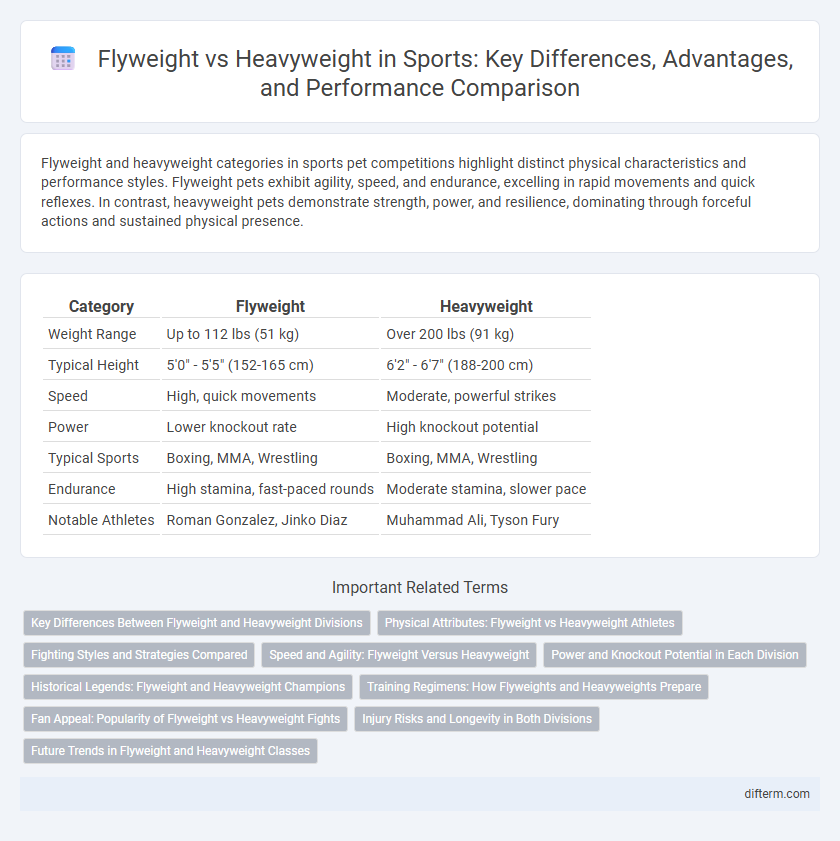Flyweight and heavyweight categories in sports pet competitions highlight distinct physical characteristics and performance styles. Flyweight pets exhibit agility, speed, and endurance, excelling in rapid movements and quick reflexes. In contrast, heavyweight pets demonstrate strength, power, and resilience, dominating through forceful actions and sustained physical presence.
Table of Comparison
| Category | Flyweight | Heavyweight |
|---|---|---|
| Weight Range | Up to 112 lbs (51 kg) | Over 200 lbs (91 kg) |
| Typical Height | 5'0" - 5'5" (152-165 cm) | 6'2" - 6'7" (188-200 cm) |
| Speed | High, quick movements | Moderate, powerful strikes |
| Power | Lower knockout rate | High knockout potential |
| Typical Sports | Boxing, MMA, Wrestling | Boxing, MMA, Wrestling |
| Endurance | High stamina, fast-paced rounds | Moderate stamina, slower pace |
| Notable Athletes | Roman Gonzalez, Jinko Diaz | Muhammad Ali, Tyson Fury |
Key Differences Between Flyweight and Heavyweight Divisions
Flyweight and heavyweight divisions differ primarily in athlete weight, with flyweights weighing up to 112 pounds (51 kg) and heavyweights exceeding 200 pounds (91 kg). Flyweight fighters typically exhibit greater speed, agility, and endurance, while heavyweights rely on power, strength, and knockout capability. Training regimens and fight strategies are tailored to these physiological differences, influencing pacing, offensive techniques, and defensive tactics in competition.
Physical Attributes: Flyweight vs Heavyweight Athletes
Flyweight athletes typically weigh between 112 to 125 pounds and exhibit exceptional speed, agility, and endurance due to their lighter body mass. In contrast, heavyweight athletes often exceed 200 pounds, relying on greater muscle mass, strength, and power to dominate physical confrontations. The stark difference in physical attributes between flyweights and heavyweights shapes their distinct fighting styles and competitive strategies.
Fighting Styles and Strategies Compared
Flyweight fighters prioritize speed, agility, and rapid combinations to outmaneuver opponents, utilizing high-volume strikes and evasive footwork. Heavyweight fighters rely on power, endurance, and strategic pacing, often focusing on single devastating blows and controlling the octagon with strength and reach. The contrasting fighting styles highlight flyweights' emphasis on precision and endurance while heavyweights capitalize on knockout power and physical dominance.
Speed and Agility: Flyweight Versus Heavyweight
Flyweight athletes excel in speed and agility, demonstrating rapid footwork and quick reflexes crucial for evading heavy strikes. Heavyweight competitors rely more on power and reach, which can limit their movement speed and agility compared to lighter fighters. These differences influence fight dynamics, with flyweights often outpacing heavyweights through swift combinations and evasive maneuvers.
Power and Knockout Potential in Each Division
Flyweight fighters rely on speed and technical precision, generating power through rapid combinations rather than sheer force, resulting in fewer knockouts but high-volume striking. Heavyweight boxers wield immense power, often delivering single, decisive blows that lead to a higher knockout rate and the ability to end fights abruptly. The knockout potential in heavyweights is significantly greater due to their mass and strength advantages, while flyweights emphasize endurance and tactical point scoring.
Historical Legends: Flyweight and Heavyweight Champions
Flyweight and heavyweight divisions have produced legendary champions who defined eras in boxing history, such as Jimmy Wilde, the "Ghost with a Hammer in His Hand," dominating flyweight in the early 20th century, and Muhammad Ali, the charismatic heavyweight icon known for his skill and charisma. Flyweight champions like Panamanian Michael Carbajal revolutionized speed and agility in the ring, while heavyweight legends including Joe Louis and Mike Tyson showcased unparalleled power and aggression. The contrasting styles and storied careers of these champions highlight the rich diversity and evolution of boxing across weight classes.
Training Regimens: How Flyweights and Heavyweights Prepare
Flyweight fighters prioritize speed, agility, and endurance in their training regimens, incorporating high-repetition cardio drills and fast-twitch muscle conditioning to maintain quickness throughout bouts. Heavyweights emphasize strength and power through heavy resistance training, explosive plyometrics, and low-repetition weightlifting to maximize force behind each strike. Both divisions tailor their nutrition and recovery strategies to support their unique energy demands and optimize performance within their weight classes.
Fan Appeal: Popularity of Flyweight vs Heavyweight Fights
Heavyweight fights consistently attract larger audiences due to the fighters' significant size and power, making these bouts more visually dramatic and widely promoted. Flyweight matches, while showcasing faster, more technical skill and endurance, tend to appeal to niche fans who appreciate agility and speed over brute force. The disparity in fan appeal largely stems from mainstream media coverage favoring heavyweight events, which contributes to higher pay-per-view buys and stadium attendance.
Injury Risks and Longevity in Both Divisions
Flyweight fighters typically experience fewer and less severe injuries due to their lighter body mass, which reduces impact forces during bouts, contributing to potentially longer careers. Heavyweight competitors endure higher risks of traumatic injuries, including concussions and joint damage, because of the increased power behind punches and heavier physical exchanges. The disparity in injury severity directly influences career longevity, as flyweights often sustain less cumulative trauma, allowing extended active years compared to the more physically punishing heavyweight division.
Future Trends in Flyweight and Heavyweight Classes
The flyweight and heavyweight classes are poised to witness significant advancements with emerging training technologies and data analytics that enhance fighter performance and strategy. Increasing emphasis on speed and agility in heavyweight divisions contrasts with growing power and endurance developments in flyweight categories, signaling a recalibration of fight dynamics. Innovations in nutrition and recovery techniques are expected to blur traditional weight class distinctions, promoting more versatile athletes across both divisions.
flyweight vs heavyweight Infographic

 difterm.com
difterm.com